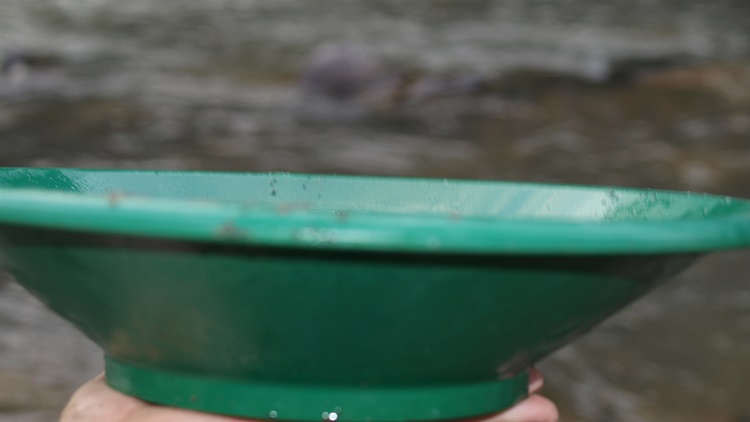
Any commercial gold pan will work, but certain features are preferred by most prospectors.
Whether you are a seasoned or a novice prospector the selection of a gold pan is important to your success in finding gold. Different factors such as the design, the shape, the color and even the materials might affect your efficiency when it comes to processing the gold bearing gravels and this will have an impact your overall success.
The truth is a gold pan is a very important tool for gold prospecting, even for the larger placer mining operations. They aren’t used to process the gravels, but instead are used for sampling, and in some cases the final clean up the gold.
This means that getting the right pan is important because your personal preference will affect your results when it comes to sampling gold bearing gravel and cleaning up your gold find.
To get the right pan you need to consider a number of factors.
Plastic or Metal Pans
The material with which a gold pan is made of is an important factor to consider when choosing the right pan for you. Gold pans are usually made of either plastic or metal.
Plastic pans are loved by many prospectors because they are resistant to rust and thus great for those people who are not avid prospectors but want to engage in the activity once in a while. A high impact plastic is used to make the pans and thus they are both durable and light in weight.
Plastic is light in weight and thus perfect for children who will find metallic pans heavier. The plastic pans are non-metallic and also great for use with a magnet to separate the gold from the magnetic black sands.
Most prospectors are using plastic gold pans these days.
Metal pans have been used since the gold rush days. They are most often made from two types of metal, steel pans and copper pans.
Steel is the most popular because it is the older of the two quite inexpensive, but it is prone to rust and therefore the pans should be thoroughly dried after use and then stored in dry conditions until the next use.
It is important that you remember to blacken your steel pan by burning it before using it for the first time. The old-timers would just throw it in a fire, but you will get better results by heating it up on the stove. This will give a more consistent heat treatment.
It is easy to spot gold on a dark surface hence the need to blacken your new steel pan. Copper pans are rarely used for gold panning. However, if you want to mine gold using the mercury amalgamation process then you will need a copper pan. It works best with this clean-up process although mercury is rarely used these days for gold recovery.
Pan Design/Shape

Gold pans come in a number of shapes and design. It is important that you pick a design the best works for you. All different shapes and styles will work, but most prospectors have their preferences.
One of the most popular designs is the drop bottom or simply the drop center pans. These gold pans are designed with their bottom made in such a way that it is deeper than the conventional pans you know. The deeper bottom makes the trapping and refining of gold nuggets a lot easier.
The other popular designs are the odd-shaped pans. These come in a wide range of shapes including triangles, rectangles, and hexagons. They are referred to odd shaped pans because traditionally manufacturers of gold pans experimented with different shapes.
What you choose to do is merely a matter of personal preference. Since gold pans are relatively inexpensive, I recommend that you buy 2 or 3 different ones and see what you prefer.
Size
Size is another important factor to consider when selecting a gold pan. A pan that is too large will present troubles not only when using them but also during transportation.
A pan that is too small may be ineffective when it comes to recovering gold from the dirt, simply because you can’t process as much gravel.
Today the most common pan sizes are those between 10 inches and 17 inches in their diameter. A small size such as a 10-inch diameter pan is great when it comes to storing it and backpacking with it, but processes fewer material can really have an impact on how much gold you recover in a day.
The large pans such as the 17-inch diameter pans are perfect for processing more materials at a time, but can be very tiring to use and may bring logistical nightmare where it comes to moving around. The right size for most average sized men is somewhere in between 17 inches and 10 inches.
For most gold prospectors, a pan with a 14″ diameter will be a perfect size.
Color
Color may not be a big factor to many people, but certain colors provide better contrast with small pieces of gold. Particularly if you have poorer vision, it can be worth experimenting around with.
Gold pans come in the same colors: black, blue and green for the plastic ones. One color is not necessarily better than the other, but you will need to experiment for yourself to see which color you find is the best contrast.
I personally like a green gold pan.
If you are buying a metal pan then you will have to blacken it by burning it in a flame before you start using it. It’s also a good idea to give any new gold pan a good wash with soap and water before use. Factory oils can prevent gold from catching and increase the amount of losses.







